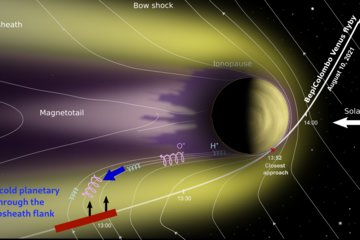All genres
541.
Journal Article
Sunspots: An overview. Astron. Astrophys. Rev. 11, pp. 153 - 286 (2003)
542.
Journal Article
SUNRISE: Balloon-borne high-resolution observation of the Sun. Astron. Nachrichten 324, p. 113 (2003)
543.
Journal Article
Can solar variability explain global warming since 1970? Journal Geophysical Research 108 (A5), 1200 (2003)
544.
Journal Article
Three-dimensional magnetic field topology in a region of solar coronal heating. Nature 425, pp. 692 - 695 (2003)
545.
Journal Article
Sonne spielt nur untergeordnete Rolle. Chemische Rundschau 13, pp. 29 - 30 (2003)
546.
Journal Article
Spatial and temporal fluctuations in sunspots derived from MDI data. Astronomy and Astrophysics 411, pp. 249 - 256 (2003)
547.
Journal Article
Millenium-scale sunspot number reconstruction: Evidence for an unusually active Sun since the 1940s. Physical Review Letters 91, 211101 (2003)
548.
Journal Article
Hot loop oscillations seen by SUMER. Astron. Nachrichten 324 (4), p. 340 (2003)
549.
Journal Article
Hot coronal loop oscillations observed with SUMER: Examples and statistics. Astronomy and Astrophysics 406, pp. 1105 - 1121 (2003)
550.
Journal Article
Slow-mode standing waves observed by SUMER in hot coronal loops. Astronomy and Astrophysics 402, pp. L17 - L20 (2003)
551.
Journal Article
On the nature of moving magnetic feature pairs around sunspots. Astronomy and Astrophysics 399, pp. 755 - 761 (2003)
552.
Journal Article
Interplanetary and solar surface properties of coronal holes obseved during solar maximum. Journal Geophysical Research 108 (A4), 1144 (2003)
553.
Journal Article
The molecular Zeeman effect and diagnostics of solar and stellar magnetic fields. I. Theoretical spectral patterns in the Zeeman regime. Astronomy and Astrophysics 385, pp. 701 - 715 (2002)
554.
Journal Article
Models for solar magnetic loops. II: Comparison with SOHO observations on the solar disk. Astronomy and Astrophysics 383, pp. 661 - 677 (2002)
555.
Journal Article
Quiet-Sun variability observed with SUMER and CDS. Astronomy and Astrophysics 385, pp. 257 - 263 (2002)
556.
Journal Article
The 1.3-year and 156-day periodicities in sunspot data: wavelet analysis suggests a common origin. Astronomy and Astrophysics 394, pp. 701 - 706 (2002)
557.
Journal Article
Was one sunspot cycle in the 18th century really lost? Astronomy and Astrophysics 396, pp. 235 - 242 (2002)
558.
Journal Article
On the intensity contrast of solar photospheric faculae and network elements. Astronomy and Astrophysics 388, pp. 1036 - 1047 (2002)
559.
Journal Article
The magnetic structure of sunspots and starspots. Astron. Nachrichten 323, pp. 165 - 177 (2002)
560.
Journal Article
Solar variability and climate change: is there a link? 2001 Harold Jeffreys Lecture. Astron. Geophys. 43 (5), pp. 9 - 5 (2002)











